
About UsThe Numismatic Bibliomania Society is a non-profit organization promoting numismatic literature. For more information please see our web site at coinbooks.org SubscriptionsThose wishing to become new E-Sylum subscribers (or wishing to Unsubscribe) can go to the following web page link MembershipThere is a membership application available on the web site Membership Application To join, print the application and return it with your check to the address printed on the application. Membership is only $15 to addresses in the U.S., $20 for First Class mail, and $25 elsewhere. For those without web access, write to: David M. Sundman, Secretary/TreasurerNumismatic Bibliomania
Society AsylumFor Asylum mailing address changes and other membership questions, contact David at this email address: dsundman@LittletonCoin.com SubmissionsTo submit items for publication in The E-Sylum, just Reply to this message, or write to the Editor at this address: whomren@coinlibrary.com
BUY THE BOOK BEFORE THE COINYou won't regret it! |
- WAYNE'S WORDS: THE E-SYLUM MAY 1, 2011
- LAKE BOOKS 107TH MAIL BID SALE PRICE REALIZED AVAILABLE
- BOOK REVIEW: COINS OF THE BRITISH VIRGIN ISLANDS
- BOOK REVIEW: MILITARY TOKENS IN 'A GUIDEBOOK OF UNITED STATES TOKENS AND MEDALS'
- SMITHSONIAN RECEIVES GLENNA GOODACRE'S SACAGAWEA DOLLAR MATERIALS
- DICK JOHNSON ON THE VITAL IMPORTANCE OF NUMISMATIC NUMBERING SYSTEMS
- COOLE CHINESE COINS TO BE OFFERED
- NOTES FROM E-SYLUM READERS: MAY 1, 2011
- NUMISMATIC VOCABULARY: WHAT'S THE DIFFERENTS?
- MORE ON THE U.S. GOLD COIN HOARD FOUND IN EAST LONDON
- SWEDEN LAUNCHES BANKNOTE DESIGN COMPETITION
- FEATURED WEB PAGE: COINAGE OF SAXONY
WAYNE'S WORDS: THE E-SYLUM MAY 1, 2011

Among our new subscribers this week are Meghan McKeon of F+W Media, Inc., and Ray Bows, courtesy of Howard A. Daniel III. Welcome aboard! We now have 1,422 email subscribers, plus 136 followers on Facebook, including Franklin Leite Chucre and Kenny Meredith.
This week we open with an update from Fred Lake and a review of a new book on coins of the British Virgin Islands. Next up is a lengthy review from Ray Bows of the military coinage section of Whitman's Guide Book of U.S. Tokens and Medals. Other topics include a new donation to the national Numismatic Collection at the Smithsonian Institution and numismatic numbering systems.
To learn more about the Chinese coin collections of Daniel K.E. Ching and the Arthur Coole family, "differents" and a Swedish banknote design competition, read on. Have a great week, everyone!
Wayne Homren
Numismatic Bibliomania Society
LAKE BOOKS 107TH MAIL BID SALE PRICE REALIZED AVAILABLE
The prices realized list for our 107th mail-bid sale of numismatic literature is now available for viewing on our web site at www.lakebooks.com/current.html
We will be bit slower than usual in shipping lots to the winning bidders as both my wife, Joan (the packer-in-charge) and I are hobbled a bit by some pesky back problems. We'll do our best to continue the kind of service that you have come to expect from Lake Books.
Our next sale will be held on July 12, 2011 and will feature selections from the library of Lucien (Lou) Philippon, a noted collector of Early American coinage.
BOOK REVIEW: COINS OF THE BRITISH VIRGIN ISLANDS
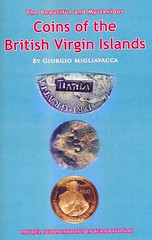 A new book narrating the story of the British Virgin Islands coins of the 1800s and 1900s has just been published by Laurel Publication International.
A new book narrating the story of the British Virgin Islands coins of the 1800s and 1900s has just been published by Laurel Publication International.
The well-documented, ground-breaking work has a foreword by Michael O'Neal, PhD, Senior Research Fellow, Island Resources Foundation.
"Coins of the Virgin Islands" is a significant contribution to the memory bank of Virgin Islands history," Dr. O'Neal said.
The Author of "The Beautiful and Mysterious Coins of the British Virgin Islands" is BVI Philatelic Society president Dr. Giorgio Migliavacca.
The findings of years of research on archive sources and lesser known published works are presented by the Author who has achieved a good balance between the historical background, the slavery issue and the numismatic focus.
Migliavacca's presentation of numismatic aspects is humanistic rather than strictly scientific and provides a much wider picture.
In fact, the Author throws new light on the role of local coinage during the 1800s utilizing newly uncovered and significant archival material. Modern coins and Virgin Islands currencies from the 1800s to date are also examined.
"This book goes beyond the numismatic side of the story and explores the socio-economic facets revealing important aspects that have not emerged before in history books. Virgin Islands coinage dates back to the early 1800s. On 3 February 1801, an Act was passed by the local Legislature to stamp, or counter-mark, silver and copper coins in order to create an insular coinage," Migliavacca said.
"In the Virgin Islands, slaves hoarded the local coins to buy their freedom, and emancipated blacks used "cut money" to buy estates, big and small. Even before emancipation, slaves, free blacks and Liberated Africans used Virgin Islands coins every day of the week. The local coinage was not a simple witness, it became part of unprecedented and unsuspecting changes: from the abolition of slavery, to emancipation, to apprenticeship, to the dark, long and hopeless days of economic stagnation. "Cut money" became the key that opened the gate of true freedom, resulting in a sense of self reliance, autonomy, and security that still typifies the Virgin Islands of the third millennium," said Dr. Migliavacca.
Migliavacca's narrative style makes easy reading and will prove of great interest to both coin collectors and persons interested in Virgin Islands and Caribbean history.
The 52-page book is generously illustrated with well-chosen colour photographs. It is available at booksellers and outlets in the Virgin Islands and at The Island Sun office at 112 Main Street.
Dr. Migliavacca is a member of the British Virgin Islands Stamp Advisory Committee since 1987. He has written articles for the ancient coins magazine Celator, and has contributed entries to the International Dictionary of Numismatics.
To read the complete article, see: New book on old VI coins publishe (bvinews.com/bvi/new-book-on-old-vi-coins-published/)
For those of us who don't happen to live in the British Virgin islands, Jon also forwarded this eBay link: COINS OF THE BRITISH VIRGIN ISLAND (cgi.ebay.com/COINS-BRITISH-VIRGIN-ISLANDS-new-Book-new-new-/260772148553)
KOLBE & FANNING JUNE 2, 2011 SALE HIGHLIGHTS
Key Works on Various Topics IncludingRay Byrne's photographic archive;
An 1760 work depicting an Admiral Vernon medal;
Nearly 200 lots from the Ira Rezak Library, featuring works on
Russian coins and medals;
Medina's Medallas de Proclamaciones and Monedas Hispano-Americanas;
Ira Rezak's notable Russian numismatic research files;
An extensive run of 97 complete volumes of The Numismatic Chronicle,
1881–2004, mostly bound and generally fine
Catalogue Available at Our Web Site: www.numislit.com
Printed Catalogues $10.00
KOLBE & FANNING NUMISMATIC BOOKSELLERS
141 W JOHNSTOWN ROAD, GAHANNA OH 43230-2700
(614) 414-0855 • df@numislit.com • GFK@numislit.com
BOOK REVIEW: MILITARY TOKENS IN 'A GUIDEBOOK OF UNITED STATES TOKENS AND MEDALS'
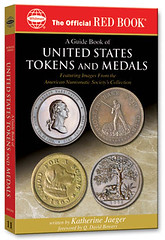 A Critique of Military Token
Listings and Passages in Katherine Jaeger's
A GUIDEBOOK OF UNITED STATES
TOKENS AND MEDALS
A Critique of Military Token
Listings and Passages in Katherine Jaeger's
A GUIDEBOOK OF UNITED STATES
TOKENS AND MEDALS
by Master Sergeant Ray Bows, US Army (ret.)
Just as Tokens and Medals – A Guide To The Identification and Values of United States Exonumia by Stephen P. Albert and Lawrence E. Elman in 1992 expanded my collecting interests of exonumia well beyond my deep interest in military tokens and unofficial military medals of the United States and foreign countries, so was Katherine Jaeger's A GUIDEBOOK OF UNITED STATES TOKENS AND MEDALS a shot in the arm to my collecting interests. Jaeger's crisp descriptions and understandable commentary, as well as Whitman's outstanding photographs, call out to all collectors to expand into every avenue of exonumia which they have not yet explored.
I have been collecting military tokens since stationed at Camp Mercer, Korea in 1963, and since have received literary awards from TAMS, NTCA and the Numismatic Literary Guild, for "The Buffalo Nickel of the 17th Infantry Regiment", "The Tokens and Exonumia of Fort Sheridan, Illinois", "United States and Allied Military Tokens of Vietnam", "Military Slot Machine Tokens of Okinawa" and a few other books and articles. I mention these awards only to establish my credibility, and because I hope that my comments about the fine work of Ms. Jaeger are taken both seriously and constructively. In devoting the last 48 years to the study of U.S. military tokens and related military monies, long ago I recognized that most of the catalogers of both early and late military tokens have no record of military service, and therefore rely only on a cursory understanding of the subject of their cataloging specialties. In listing known pieces and giving approximate values they consider their jobs complete, after-all, all many collectors and dealers actually want is a price guide to their chosen collecting field.
I am compelled in this review to note disturbing assumptions made in the catalog that truly need clarification. One of my mentors once explained that the NCOI heritage is the underpinning of our military strength, and that senior sergeants are the ones who actually transmit the living army's story from generation to generation, and I take that task seriously. I feel a need to note corrections that should be made before another edition is published, and do this before misnomers and misinformation stick. I remember the first time I heard a coin dealer refer to 90% silver coin as "junk silver" instead of "bulk silver" at which I chuckled, but now with Whitman using "junk silver" as the acceptable term for 90%, I realize that when improper word usage, or incorrect terminology go on being used unchecked they become accepted by the general population.
About Sutler Tokens Commentary on Page 87
Although sutlers were indeed "civilians"; in the case of the Union Army they were appointed by Congress, had warrant officer status, and were assigned to the specific units for which they sutled. Contrary to how it was presented in the book not just anyone could "follow . . . troops around as they camped and decamped" at least not with authorization. Such peddlers and hawkers were run off. Most units were assigned a solitary sutler, with some exceptions, and it was that sutler alone who was authorized to sit at the pay table and collect loans made to the soldier in the form of tokens. The sutler's importance was such that he sat directly after the company laundress in the pay tent. Sutlers were replaced (in name only) by post traders in 1867, however some post traders called themselves "sutlers" well into the 1890's even after they were forced to move off army posts, and no longer retained government authorization to pedal goods to soldiers.
Post traders (in the Army) were abolished in 1880, but many had 18 months to dispose of their stock, while post traders in the Marine Corps existed through the end of the Spanish American War. Post Canteens came into being in 1880. The name Post Canteen was changed to Post Exchange during the period 1890 to 1892 depending on the post, because of the association that some people made with British "Wet" Canteens, which were drinking establishments for English soldiers. These oversights in the chronology are indeed bothersome.
About Company Store and Commissary Tokens on Page 88
Placing Post Canteen and Post Exchange tokens under the category of Company Store and Commissary Tokens, while listing Civilian Conservation Corps Tokens under Government Sponsored Tokens shows a total misunderstanding of the purpose by which such tokens were issued. Tokens issued by the US Army were absolutely "Government Sponsored". At Vancouver Barracks, in 1880, Colonel Henry Morrow established the first Post Canteen not to draw money out of soldier's pockets, (as company stores drew money out of miners pockets and over charged them for goods), but on the contrary was established to help his soldiers avoid public drunkenness and keep unscrupulous civilian merchants from rifling the pockets of those soldiers. Credit tokens were devised as a stop gap to insure that soldiers had the little luxuries and necessities they needed when paydays were late in coming because of long circuitous routes of pay masters. Colonel Morrow's innovation to protect soldiers certainly deserves better recognition, than do robber barons that exploited their workers in the coal mines.
About the heading 20th Century Military Commissary Tokens Page 92
First off, I saw no mention of 19th Century Post Canteen and Post Exchange checks in the volume what-so-ever. True military tokens (those sanctioned by the U.S. government) were first issued by the Subsistence Department, then part of the Quartermaster Corps, when by military order the army attempted to replace the sutlers and post traders in the 1870's. The other sanctioned tokens were Post Canteen pieces from 1880 to 1890 and Post Exchange tokens from 1890 on. These tokens were called "Pontoon Checks" because they "kept soldiers afloat from payday to day" as did pontoon bridges of the day. The term, now almost lost, was as much a part of military jargon as were terms like "fox-hole" or "dog-tags". Post Bakery tokens along with the others already mentioned were also authorized and sanctioned by the US government. Exchanges were broken down into Post Exchanges and Regimental Exchanges – one type being static, while the other was mobile. They were very, very different from each other. Post Exchanges would carry general items for the soldier and his family, while Regimental Exchanges would carry specific items – saddle soap and spurs in a Cavalry Regimental Exchange; sextants, plum bobs, hammers and work gloves in an Engineers Regimental Exchange and so on.
I have often mentioned and written about the fact French mint officials had no more knowledge of General Doyre striking 1, 2, and 5 Sol siege coins in Mainz, Germany in 1793 than the US Mint had knowledge of private companies striking tokens for Post Canteens, Post Exchanges, Regimental Exchanges and NCO clubs during the last 150 years. The siege coinage of Mainz is now an integral part of the French numismatic catalog, while somehow U.S. military tokens are still not understood as having the authority of the US government behind them. Military tokens are as much a part of "Government Sponsored Tokens" (and actually more so) than some pieces listed in Jaeger's Chapter 8 (beginning on page 113), that were issued by states verses the Federal government. I can understand the oversight – be it intentional or not – for if collectors considered military pontoon checks as being part and parcel of our US government's monetary heritage, the profound understanding would create cataloging problems within the numismatic community that would be insurmountable unless it was ordered by Royal edict that numismatic catalogers start all over again. Numismatists would literally have to reinvent the wheel.
About 20th Century Military "Commissary" Tokens on page92
In the history of the US military there has only been a handful of "Commissary" tokens issued. Other authors have called such tokens "Service Club tokens". Yet such military tokens are neither! In the Army, the military's largest issuer, they are "Sundry Fund tokens" and "Non-appropriated Fund tokens". To call them any of the other terms used by catalogers who have never actually been exposed to the military is misleading, and as if someone without the understanding of numismatics called an 1877 fifty-dollar gold coin "a marshmallow" or "a high button shoe". Neither military commissaries (the civilian equivalent of a grocery distribution operation), nor military service clubs (which are "on-post" equivalents of the USO) are in the business of extending credit to customers or operating vending machines – The commissary system is there to supply troops with rations (food) at the soldier/mess hall level, and to provide military families with food "at cost" plus a small "surcharge". Military service clubs provide the soldier with free coffee, writing paper, ping pong and pool table use – at no charge. – They have never had a need for tokens except, to my knowledge, for a penny-pinch game (penny-up-the-wall, if you will) in ASCOM City Military Complex, Korea because there were no pennies in country for doughnut dollies to conduct the game with. I somehow need to hammer home the fact that military activities like commissaries and service clubs that have no vending machines, and do not extend credit – have no use for tokens, except now in the Middle East for small change. Tokens for clubs and exchanges are used either for credit (to soldiers) or to operate vending machines, while POGS used in Iraq and Afghanistan are maintained solely to alleviate the weight of shipping tons of US coinage to bases overseas.
When mentioning "1) permanent military bases in the United States territories and on foreign soil". It needs understanding that we have NEVER had permanent military ‘bases" on foreign soil. Permanent installations are ONLY located in the US. Until recently a "base" has always been an Air Force term. US Air Force bases overseas are "Air Bases" never "Air Force Bases" – a "post" was an Army term. Permanent US Army installations (until a recent decision) were termed Forts (i.e. Fort Benning, Fort Bragg Fort Lewis etc). Semi-permanent and temporary US Army installations overseas are termed "Camps". A camp, even in the US did not become a "fort" until so declared by Congress – The only exception to this was in Panama and the Philippines when we considered them "our" territories (i.e. Fort Mills and Fort McKinley in the Philippines and Fort Kobbe and Fort Amador in the Canal Zone). Hastily prepared emplacements (during combat) overseas are termed base camps, compounds, fire bases, fire support bases, patrol bases, landing zones, and airfields. Only the largest of these installations have issued tokens during the Vietnam, Korean or post-WWII conflicts. There were a handful of locations in Vietnam given a "fort" name. Fort Page and Fort Dent come to mind. These were not forts, but so-named by uninformed unit commanders to promote esprit-de-corps.
The bottom two reverse photographs on page 92 are inverted. The reverse of the HACOM piece is a stylized sword on a shield – not a paint brush on a bloated arrowhead. On the reverse of the DAC token (Da Nang Area Command – not Da Nang Air Base nor Da Nang Air Command) the arrow inside the circle (actually a 1st Logistical Command insignia) points to 10:30 hours not to high-noon – This may seem trivial, but it is a very important point to all former 1st Log soldiers and those that received their supplies from them – Truckers in Vietnam, of which I was associated, who were expected to fight right along with the infantry. The significance of the 10:30 time frame indicated by the patch is that mission requirement dictates that it must be accomplished before the eleventh hour – the hour of finality.
About Military and Other Challenge Coins on Page 259
As far as Challenge Coins go, their origins include barroom banter, bull puckie, and balderdash, and I am not surprised that internet enthusiasts are caught up in it all and swept to a blocked doorway by the crowd. Fantasies and fables of World War I aviators keeping British pennies as change from a drink and how each man, somehow marking their coins, promised to forever keep them as a means of identification, or how a World War I aviator tied his specially struck coin in a poke around his neck, may have their separate place in the mysteries of history, but such tales seem little or nothing to do with the unit coin tradition which are often termed "Challenge Coins". It's probably senseless to attempt to refute all the concocted stories that I have heard and read concerning the origins of military challenge and commander's coins, some yarns which come from high places, and certain services in the Department of Defense yearning for long standing tradition. To attempt to establish customs in retrospect certainly borders on the ludicrous. My response to such tales is "Show us the piece that goes with your bright shining tale, and only then should we consider it after the unit coin in question has been examined."
"There is no evidence for challenge-coin use in World War II or the Korean conflict." is a totally erroneous statement on the part of Ms. Jaeger, although it does not negate her conclusion. The penny in a poke story is indeed invented, while there are numerous examples of military style challenge coins extending as far back as World War I. Unit medallions were made during, and at the end of the Great War, but so far my research shows they were only issued by US Army Infantry units. I have several different pieces in my collection, and without a doubt the 1st Infantry Division was the pioneer in this field. In that same vein, I can't stress enough that all stories of how "the challenge coin" came into being in US Army Air Corps units are unfounded rubbish, and should be ignored!"
The first actual Challenge Coins (with a Challenge theme) were issued by the military districts of Germany at the end of World War II – Criminal investigators used them in lieu of badges – There was an investigator's challenge and a verbal response of recognition by the suspect in question. Nothing happens overnight everything, even challenge coins evolve. I own a rare example of one such piece from the District of Mannheim. The first "enameled unit challenge style medallion" was again pioneered by the 1st Infantry Division in Nurnberg, Germany in October 1945. It was silver dollar size, made of aluminum and bronze in a sandwich style process. It was the first of the ubiquitous series, which are just as never ending and constantly issued, as are the stories about their origins.
The first unit coin made mandatory to be in a soldier's possession was the Buffalo Nickel of the 17th Infantry Regiment. It was issued during the Korean War – and subsequent issues were dated all through the fifties, while the 2d Infantry Division penny and the Pathfinder nickel followed. The first true challenge coins as we know them today were issued in the late 1950's through the very early 1960's. Unit coins of approximately half dollar size (32mm) were issued by Airborne Infantry Units including the 327th Airborne Infantry Combat Group, and the 1st Battalion (Airborne), 505th Infantry. Some of these pieces were holed by unit members and strung on their dog tag chains, as were pieces of the 171st Infantry Brigade, Fort Wainwright, Alaska beginning in July 1963. The later aluminum pieces were slightly larger at 35mm.
Special Forces challenges (without a challenge coin being involved) existed in Korea as early as 1963, while to my knowledge the first bar room slap-down of coins involved actual silver dollars which occurred with military members of the US Army's Rail Transportation Office while at Gare St. Lazare, in Paris, France in 1965, between soldiers handling US Army duty trains. The 10th Special Forces Group in Bad Tölz, Germany may have picked up the slap down practice from SFC Mickey Norton, now deceased, who was a veteran of the Korean War. The Challenge Coin custom went to Vietnam with the 5th Special Forces Group, but it was General Melvin Zais commanding general of the 101st Airborne who perfected the Unit Coin, the Award Coin and the Special Presentation Coin. Many others claim to have developed these institutions, but I have indisputable proof that General Melvin Zais was the father of such things.
Katherine Jaeger's 289 page book was without a doubt a monumental task, a crowning accomplishment, and a labor of love. I have learned many things through her research that I did not know about in the "civilian realm" of token collecting, and have therefore not even attempted to address them here. I sincerely hope that this review will in some small way return the debt I owe her with my newly gained knowledge, and that hopefully she has received a few points from me about military from me through this review.
To read the earlier E=Sylum article, see: BOOK REVIEW: A GUIDE BOOK OF U.S. TOKENS AND MEDALS BY KATHERINE JAEGER (www.coinbooks.org/esylum_v11n23a06.html)
SMITHSONIAN RECEIVES GLENNA GOODACRE'S SACAGAWEA DOLLAR MATERIALS
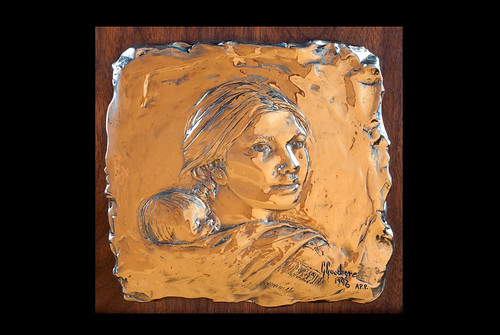
The Smithsonian's National Museum of American History has recently acquired 17 items from sculptor Glenna Goodacre from her successful commission to design the Sacagawea dollar coin released in 2000. This donation preserves the creative and technical challenges of such a design and represents an important part of American history. The materials include fired-clay coins, bronze sculptures, plaster studies and pencil-drawing proofs up to the first release of the coin in a presentation box, which will be housed in the museum's National Numismatic Collection.
Goodacre, of Santa Fe, N.M., is a nationally acclaimed artist and sculptor with a career spanning 40 years. She has created hundreds of pieces, including the bronze Vietnam Women's Memorial in Washington, D.C., and a portrait of former President Ronald Reagan, which is held at the Reagan Library in California.
"The items Goodacre donated show her love and dedication of the coin from concept to completion," said Brent D. Glass, director of the museum. "She artfully portrayed a young American Indian guide and mother whose amazing adventure still lives in the hearts, minds and imagination of the American people today."
The artist faced many challenges surrounding the design of the coin, such as no known images of Sacagawea exist. Sacagawea (c. 1788 – 1812) was a Lemhi Shoshone woman who accompanied the Lewis and Clark expedition of the Western United States acting as their interpreter and guide. Goodacre used Shoshone college student Randy'L Teton as a model and dressed her in an authentic period beaded leather dress. Logistical issues included the project specifications that stated that the image was not supposed to touch the coin's border inscription yet the central image had to be large enough to be clearly visible.
"It was a great honor for me to sculpt my own design for the Sacagawea Dollar, to work with the wonderful U.S. Mint engravers and staff who took my drawings and studies all the way through to an actual minted coin," said Goodacre. "It was a unique experience for a sculptor like me and the high point of my long career as an artist. The Smithsonian is the perfect home for my preliminary coin material, and I'm proud to have my work in the National Numismatic Collection."
Goodacre experimented with many designs for the coin—head studies, standard profile, a standing figure of Sacagawea pointing the way. She also wanted to feature images of Sacagawea with her infant son, who accompanied her on the expedition, and express Sacagawea's ability to communicate with the tribes the group met as it made its way through unknown territories.
After a general call for designs, the six top candidates were put on the U.S. Mint website for a public vote and three of Goodacre's submissions proved to be the most popular. The design process continued until 1999 when all parties were satisfied, and it was unveiled at a White House event hosted by First Lady Hillary Rodham Clinton.
The final design shows a head/shoulder view of Sacagawea with her infant son sleeping peacefully on her back. The U.S. Mint also asked Goodacre to sculpt the bas-relief for the coin herself, which makes her one of only a handful of private-sector artists in history who have created an American coin.
To read the complete article, see: Smithsonian's National Numismatic Collection Receives Sacagawea Dollar (www.artdaily.org/index.asp?int_sec=2&int_new=46868)
DICK JOHNSON ON THE VITAL IMPORTANCE OF NUMISMATIC NUMBERING SYSTEMS
Fred Schwan writes:
Regarding the Agricultural Medals book, I read Dick Johnson's earlier detailed review. Dick made a comment that really caught my eye. Here is what he said:
"I was also impressed with your numbering system -- technically called a geographic-numeric open number system -- for the ease in which to add more specimens in the future while retaining the existing numbers."
So here is my question. What is the source that designates the names of numbering systems? I like the name and its purpose, but I want to read more about the technical source!
Every cataloger of numismatic items has a duty to choose a numbering system convenient to the items he is describing. Fred Schwan asked about a term I used in describing the numbering system Andy Harkness' chose for his listing of Agricultural Society medals in his recent book.
I complimented Andy for his choice of the numbering system he used. I called it "geographic-numeric open number system." It fit the items he was describing like a glove.
Fred asked if this is from some published source or is this just something I made up. It is closer to the latter, but I had intended to publish something about numismatic numbering systems -- perhaps an entire chapter in a book I would someday like to write, "How to Catalog Coins, Medals and Tokens." (Unfortunately it ranks 5 in current priority list of numismatic books to write).
I will extract some text on numbering systems I had prepared from my Encyclopedia of Coin and Medal Technology (even before this is published). Creating a number system is the equivalent of creating numismatic shorthand. A number or letter-number combination is shorthand for a long name., plus it aids in arranging the items in order at any later time It is applied to only one variety and once it is published for all to use it becomes embedded in numismatic literature. We have seen auction catalogs with only three elements -- lot number, catalog number, condition. That is enough information for a potential buyer to intelligently bid on.
As a cataloger gathers a large number of specimens in his chosen topic, he must arrange these in some order. This is the key to his numbering system. This can be chronological, geographical or some other sequential method. Numismatic items with a lot of varieties require a different system, for example, from that with a run of one-of-a-kind items.
Here is a list I mention in my entry on numbering system in my Encyclopedia: Straight numerical, Open numerical, Numerical, Outline, Straight decimal, Consecutive decimal, Letter-number combination, Numerical coding for data processing (often with zeros in front of integral numbers) or a variety of alpha-numeric combinations of these.
Problems arise after the catalog is published and newly discovered varieties need to be added to the arrangement. How easy to add these is a factor of the number system.
Here are some examples:
Straight numerical -- Hibler & Kappan's So-Called Dollars. Pro: Their arrangement was chronological so their number system retained this. Con: They numbered every variety in that same sequence, so new varieties have no place to be added. This was a problem for the editors of the second edition of this work.
Open numerical -- Walter Breen's Encyclopedia of Colonial and U.S. Coins. Pro: he left open numbers to be added for denominations currently being struck. Excellent. Con: He could not have anticipated bullion coins being issued by the U.S. Mint, thus there are no open numbers for these -- they must be relegated to the end of his numerical system.
Outline -- If anyone remembers NASCA auction catalogs, it was their policy not to renumber the lots but to add late lots in proper sequence but to number the lots with an outline number. Pro: they got in. Con: it was very confusing.
Letter-Number combination -- Best example is Bob Julian's Medals of the United States Mint of the first Century.
Coding for data processing -- Some of George Fuld's early writings on Lafayette and other series were chosen for compatability with data processing, then newly in use.
We could list dozens more, each with their good points and bad.
Muling , for example, creates problems, where it may be ideal to number both obverses and reverses. But this is a no-no for most everything else. [for his list of medals sculptor Joseph Colletti gave separate numbers to both an obverse and reverse even that had only one reverse. This is ONE item for cataloging, not two.
Tip for catalogers when using multiple element catalog numbers: make it one word. Connect the elements with a period, dash, slash or such. And the reason for that is everyone has unrestricted use to that number. You cannot copyright one word, thus it is in public domain once it is published. You can, if you wish, mention, say, on the copyright page how you would prefer these items to be cited, with the cataloger's initials or full last name or however. But no need to put your initials on every item (as the authors did in the recent publication The Secret History of the First United States Mint.
Fred, this reply may not satisfy your inquiry - the best advice at this time: arrange items before deciding a number system. Then use common sense in choosing a number system.
To read the earlier E-Sylum article, see: BOOK REVIEW: AGRICULTURAL AND MECHANICAL SOCIETY MEDALS OF THE U.S. (www.coinbooks.org/esylum_v13n51a07.html)
HOW MANY OF THE 100 GREATEST MODERN COINS
DO YOU OWN?
COOLE CHINESE COINS TO BE OFFERED
Attached is some biographical information on Daniel K. E. Ching which I found online. This is from the website of the Chinese Historical Society of America, 965 Clay Street, San Francisco, CA 94108 (www.chsa.org). Dan's collection of Chinese coins and paper money was sold in a Scott Semans auction in June 1991 (with less valuable material appearing in later fixed price lists). I wrote most of the catalog for that sale. The catalog can still be purchased from Scott (www.coincoin.com).
Dan had passed away on 26 July 1990, while the catalog was being written. We knew that he had donated other parts of his collections to various museums, and that his Vietnam tokens were auctioned by a token dealer, but his collection of Chinese-American memorabilia was still looking for a home in the early 1990's. Now we know that it went to the Chinese Historical Society in San Francisco (www.chsa.org) in 1994.
The well-known collector of Chinese coins, Arthur B. Coole (1900-1978), sold his collection of Chinese coins and paper money to Kansas City coin dealer Jack Klausen in 1964. In the fall of 1963 he prepared an inventory of the collection, and published about 15 copies for Klausen and various friends. Coole asked Klausen to agree not to break up the collection -- that is, if Klausen sold it he should sell it intact. Klausen agreed and hoped to sell the collection to a museum. He was unable to do so, and during 1977-1978 sold the collection to Taiwan coin dealer, J. S. Lee.
Years later it turned out that Lee did not buy all of the collection. There were some parts on which apparently they could not agree on a price. In 1988 Klausen consigned the coin trees, coin molds, and paper money printing blocks and seals to a Taisei sale, but they did not sell (despite published prices realized for those lots). I believe he consigned them to a different sale in the early 1990's (perhaps Pacific Coast Auctions). Whether they sold at that time or not is unclear, but the material was donated to a museum in Texas, either by the 1990's buyer or by Klausen's estate after his death in 2006.
The collection has now been consigned to Kansas City coin dealer, Lyn Knight, and will be offered in his Memphis Paper Money Show auction in June 2011. I have been cataloging part of this collection, which includes 22 Ch'ing Dynasty banknote printing plates (dating to the 1850's to 1912); about 40 seals, at least some of which were used on paper money of the late 1800's or early 1900's; a Yuan Dynasty (1280-1368) printing plate (of which perhaps 10 are known, but only 2 or 3 in private hands); and about two dozen coin molds (some in bronze, some clay and some in stone) dating to about 300 BC to about 200 AD.
In addition there is a lot of paper money, which I don't believe has appeared in those two previous sales. There are also three artist's drawings for proposed dragon coins, done in 1911, which originally had with them two passes to the imperial palace and a biography of the artist. These drawings have never been published before, and may be the work of Luigi Giorgi, the best known engraver of Chinese coins. Also in the sale are some items Klausen added to the collection after he bought it, including hundreds of Sinkiang silver coins, and I believe some gold pieces, though I haven't seen these.
Previous writers in The E-Sylum have stated that part of Coole's collection was donated to Baker University in Baldwin, Kansas. This is not true. Coole's father, Thomas Coole, was also a Methodist missionary in China and also a coin collector. Thomas Coole left his collection to Baker University, and Arthur mounted it and presented it to the university in 1930. I was hired to appraise the collection in the 1980's, and it was later donated by the university to the ANA Museum in Colorado Springs.
Arthur Coole had left his library to the ANA, and it may be seen there today. Strangely, though Arthur Coole and his father and his daughter and various other members of his family graduated from Baker, he did not leave his papers (correspondence, articles written, and probably diaries) to Baker University. Instead they are now at the Knight Library at the University of Oregon (1501 Kincaid, Eugene, OR 97403). This library has the papers from many other Methodist missionaries in China, which may explain why Arthur Coole's papers are there.
Lyn Knight may be contacted at www.lynknight.com for more information.
Daniel K.E. Ching Biography
Daniel Ching's first family ancestor to come to America was Chinn Mook, who was born in approximately 1861 in Huizhou (now Huiyang), Guangdong Province, and who emigrated to Hawaii in 1881. Daniel K.E. Ching (Chen Jingyuan) was born in Honolulu on June 11, 1931, and went to Napa, California, in 1940 after living with relatives when his parents separated. He graduated from Pacific Union College in 1955 and moved to Denver. Ching returned to California in 1969 to work for Pacific Bell Telephone Company in Los Angeles as an accounting executive in public communications. In 1989 Ching was given a medical disability retirement because of a degenerating health condition caused by hemochromatosis, a genetic blood disease. His anemia added to his health complications, and he passed away on July 26, 1990.
When Ching lived in Denver, he met Reverend Arthur B. Coole, a Methodist missionary who introduced him to Chinese Numismatics. Ching eventually became nationally known in the numismatic world not only as a collector, but also as a writer of over thirty articles, mostly published in World Coin News, and as the Chinese coin cataloger for Krause Publications in Iola, Wisconsin. In addition to Chinese coins, he collected Chinese stamps and had an extensive collection of military badges, flags, souvenir items, books, picture postcards, and paper money from Manchukuo.
While working at Pacific Bell, he also acquired a collection of telephone tokens. Of most value to Chinese American studies is Ching's collection of popular American artifacts that depicted the Chinese in China or America, images that disturbed him until the day he died. Ching's coin collection has been auctioned and his Manchukuo collection has been donated to a museum in Manchuria. As for his Chinese American collection, he wanted it to go to a museum or historical society that would not keep it in storage but would ensure that future generations would not forget how the Chinese were portrayed in America's past. Through the recommendation of Emma and Paul Louie, the Chinese Historical Society of America was chosen to be the recipient of the collection.
In April 1994, CHSA joined forces with the SFSU Asian American Studies Department to work on the Ching Project. Philip P. Choy, Loraine Dong, and Marlon K. Hom are the project coordinators. To date, over sixty volunteers, students, and work-study students have begun to preserve and catalogue the collection, which is currently estimated to comprise over ten thousand items dating from the 1800s to the present. They include postcards, trade cards, sheet music, piano rolls, records, books, magazines, newspaper, prints, posters, paintings, photographs, stereocards, toys, dolls, games, household items, and souvenir trinkets.
In March and May of 1996, three graduate students from SFSU's College of Ethnic Studies introduced the Ching Collection at CHSA's March meeting and at two Association of Asian American Studies conferences held in Hawaii (regional) and Washington, D.C. (national). What follows is a portion of the conference presentation, focusing on one of the major genres found in the Ching Collection — trade cards. In the conference, James Chan introduced some of the themes found in trade cards, Dina Shek discussed the Asian female images in sheet music, and Dennis Park reviewed the depictions the Chinese male in these historic images.
To read the complete article, see: Daniel K.E. Ching Biography (www.chsa.org/2005/03/05/daniel-k-e-ching-biography/)
NOTES FROM E-SYLUM READERS: MAY 1, 2011
Regarding our discussion of the numismatic collection at the Fitzwilliam museum, Chris Fuccione commented on Facebook:
"Too bad it is located in Cambridge, England, not Cambridge, Massachusetts".
P.K. Saha forwarded this image, noting:
Germany has announced that its circulating 10 Euro coin on 125th Anniversary of Automobiles, which was to be issued on May 3rd, 2011 and was to be of silver, would now be of Cupro Nickel. This is due to the high rise in silver price. As a result, the issue date has also been deferred.
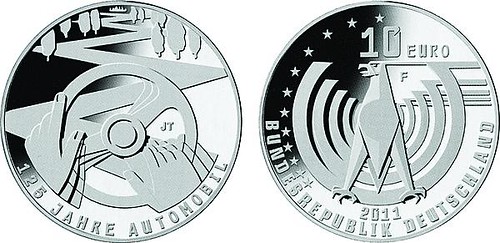
Howard A. Daniel III writes:
A while back I started a discussion about the poor design on a "coin" (like a Challenge coin) that was designed for President Clinton's visit to Viet Nam in 2001. This time, I want to submit a design that was exactly right on. The obverse has the national emblem of the Republic of Indonesia. The reverse has Marine Security Guard Detachment * Jakarta Indonesia * around the rim; and the US Flag, USMC Flag, USMC Emblem and Country, Semper Fidelis and Country in the center. Anyone knows what the "coin" represents and the advanced collector will not find any errors in the design versus the President Clinton "coin" making several errors because of inadequate research. "Good job, Marines."


To read the earlier E-Sylum article, see: PRESIDENT CLINTON VIETNAM VISIT CHALLENGE COIN (www.coinbooks.org/esylum_v14n10a18.html)
THE BOOK BAZARRE
NUMISMATIC VOCABULARY: WHAT'S THE DIFFERENTS?
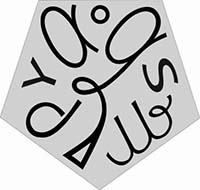 "Differents" are the distinctive punches which are used to identify French circulating coins and collector's coins minted by Monnaie de Paris. "Differents" show that the coin matches the specifications laid down by the French State and guarantee its quality, origin and authenticity.
"Differents" are the distinctive punches which are used to identify French circulating coins and collector's coins minted by Monnaie de Paris. "Differents" show that the coin matches the specifications laid down by the French State and guarantee its quality, origin and authenticity.
Since January 1, 2011 a new "different" has appeared on all coins minted by the Monnaie de Paris.
The Horn of plenty - the very first "different"
Since 1832, there has been an order in force stating that the "different" of each Monnaie de Paris' mint master must appear on all coins. Up until 1879 this punch was the personal mark of each mint master but it then became unique in 1880 when the Horn of plenty, which symbolizes Monnaie de Paris, made its first appearance on the institution's coins, where it remains to this day.
The engraver's mark – the second "different"
The second different which appears on coins besides the Horn of plenty, is the mark of the Engraver General. Their "different" appears on all coins produced by Monnaie de Paris during their term of office. The Engraver General's "different" is a signature embodying the engraving workshop. Between 2003 and 2010, the "different" of the head of the engraving workshop, Hubert Larivière, depicted a French hunting horn (the emblem of Saint Hubert), a few waves and the outline of a fish.
 A new "different" has appeared on all coins minted by the Monnaie de Paris since 1st January 2011; this is the mark of Yves Sampo, the new head of the engraving workshop. Staying true to tradition, his "different" illustrates the teamwork spirit of the engraving workshop. So this signature depicts a pentagon with the letters AG, which stand for "Atelier de Gravure" (engraving workshop) and MP standing for "Monnaie de Paris et Pessac" inside it. The motif is completed by Yves Sampo's own initials on either side of it.
A new "different" has appeared on all coins minted by the Monnaie de Paris since 1st January 2011; this is the mark of Yves Sampo, the new head of the engraving workshop. Staying true to tradition, his "different" illustrates the teamwork spirit of the engraving workshop. So this signature depicts a pentagon with the letters AG, which stand for "Atelier de Gravure" (engraving workshop) and MP standing for "Monnaie de Paris et Pessac" inside it. The motif is completed by Yves Sampo's own initials on either side of it.
To read the complete article, see: A New "different" form Monnaie de Paris' engraving workshop (www.coinsweekly.com/en/News/4?&id=566)
MORE ON THE U.S. GOLD COIN HOARD FOUND IN EAST LONDON
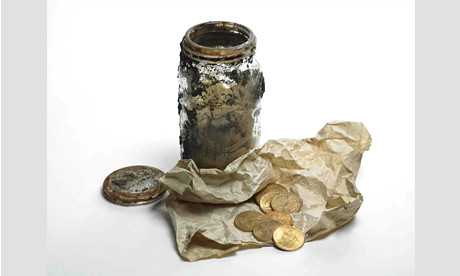
A hoard of gold coins found in Hackney by a local resident in 2007 does not qualify as treasure and should be returned to the descendent of the man who originally buried them, ruled an inquest last week (Monday 18 April).
In 2007, Hackney resident Terence Castle was digging a frog pond with three others in a back garden in Stamford Hill when they struck suddenly struck gold, discovering a glass jar containing 80 American coins dating from 1854 and worth around £100,000.
"I unwrapped the greaseproof paper the coins were wrapped in and saw the statues of liberty marching into my face in gold relief… I knew it was something special." He took the coins to his office and contacted the British Museum. He insisted that they collect the coins because "otherwise I might have just run off to Rio with them."
A treasure inquest was opened to determine the value and provenance of he coins. If coins less than 300 years old are gold or silver and appear to have been deliberately concealed, the law states that unless a superior claim is made the finder may receive a reward equal to the treasure's value.
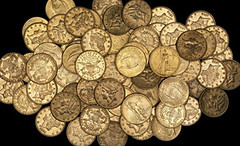 In a unique twist to the story a likely descendent of the original owner of the coins has been found.
In a unique twist to the story a likely descendent of the original owner of the coins has been found.
The twenty dollar gold coins are known as ‘Double-Eagles'. Photograph: Hackney Council A claim was made by Max Sulzbacher whose father, Martin, was a German Jewish banker living in Frankfurt who fled persecution from the Nazis in 1938 and moved to live with his family in Hackney, bringing the valuable coins with him.
The current case represents a second deposit of Martin Sulzbacher's wealth. In 1952 as work commenced on a new building on the site of Mr Sulzbacher's house, another hoard of 82 $20 American gold coins dating to 1890 was discovered in a glass jar on the same site. The hoard was awarded to Mr Martin Sulzbacher by the coroner at the time.
On 18 April 2011 the Coroner for Inner North London resumed an inquest in relation to a hoard of American gold dollars found in Hackney in 2007.
The coroner decided that Mr. Sulzbacher has a superior claim to the coins meaning that they will not qualify as Treasure according to the terms of the Treasure Act 1996, on the grounds that in order for objects to be classed as such, their owner or his or her heirs or successors must be unknown.
Mr. Martin Sulzbacher passed away in 1981 but the coroner's office, the British Museum and the Museum of London worked together to track down his son, Mr. Max Sulzbacher, who lives abroad.
To read the complete article, see:
Hackney hoard of gold coins fails to count as treasure, court rules
(hackneycitizen.co.uk/2011/04/25/hackney-hoard-of-gold-coins
-fails-to-count-as-treasure-court-rules/)
To read the earlier E-Sylum article, see: U.S. GOLD COIN HOARD FOUND IN EAST LONDON RETURNED TO OWNER'S FAMILY (www.coinbooks.org/esylum_v14n17a22.html)
THE BOOK BAZARRE
SWEDEN LAUNCHES BANKNOTE DESIGN COMPETITION
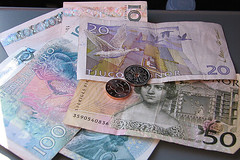 Sweden's Riksbank has announced a public competition to design a set of new banknotes. It's open to artists, designers and architects who reckon that they've got a good idea for revamping the country's currency.
Sweden's Riksbank has announced a public competition to design a set of new banknotes. It's open to artists, designers and architects who reckon that they've got a good idea for revamping the country's currency.
The Riksbank says on its website that its decided that it needs to renew its banknote and coin designs for several reasons: "Today's banknotes are of good quality, but they are 25 years old. The new banknotes and coins will give us more modern banknotes with improved security features. The new coins will be smaller and lighter. This will make transporting and handling coins simpler and cheaper, which in turn will have less impact on the environment."
The theme for the new banknotes is a selection of already-chosen Swedish cultural figures and parts of the country, so bear that in mind in your design. You'll need to create grey-brown (1000SEK), red (500SEK), green (200SEK), yellow/orange (50SEK) and violet (20SEK) variants. Riksbank also has proposed that the banknotes should have distinctive printed details that can be felt with the fingertips, as an aid to the visually impaired.
If you want to enter, then you can find out more information, and far more than you'd ever want to know about currency design, on Riksbank's website.
To read the complete article, see: Sweden launches banknote design competition (www.wired.co.uk/news/archive/2011-04/28/sweden-banknotes)
FEATURED WEB PAGE: COINAGE OF SAXONY
This week's Featured Web Page is a picture galley of the coinage of the German state of Saxony.
The coins of Saxony are easily identified by the unique Saxon primary arms, bars with crown. They appear in some form on virtually every Saxon coin, either as the primary device or a central escutcheon. The arms are often split per pale with the crossed swords representing Wittenberg on the left, an old central core of the Saxon domains, with the bars and crown on the right. "SACHSEN", "SAX", or "SAXONIE" appears in the legends.
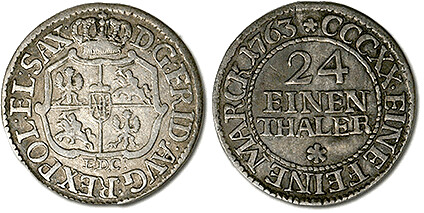
www.medievalcoinage.com/gallery/germany-saxony.htm
